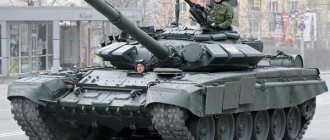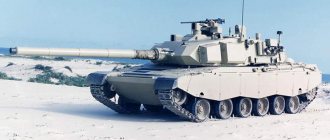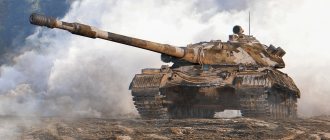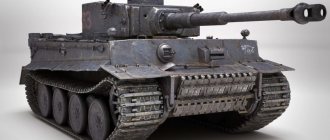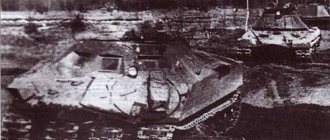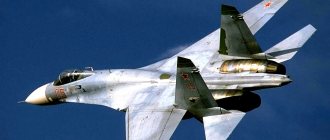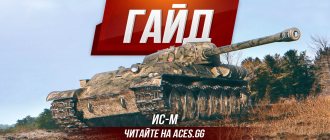Soviet missile tanks
The author leisheng has collected a lot of information on Soviet missile tanks, you can read it in this article; multiple launch rocket systems are not included in the review, although there is also a decent amount of them, especially from the Americans.
The development of missile tanks in the USSR began in 1933, when the UMM command decided to install missiles on tanks.
Abbreviations: KUV - guided weapon complex. RS - rocket.
1933. Rocket T-27
Gorokhovsky.
Armament - one RS on the roof. 1933. Rocket T-38
Gorokhovsky.
Armament - one RS on the roof. 1933. Rocket BT-2
Gorokhovsky. Armament: two PCs on the hull. In all of Gorokhovsky’s projects there was one type of rocket, but it is not known which one. This is either TT 245mm caliber, or RS-132 caliber 132mm, or RS-82 caliber 82mm.
1933. RBT-5 Tverskoy
. The first option was with one rocket, but it was not built. There were no drawings on the Internet. The photo shows the second option. Armament: two 245mm TT tank torpedoes.
1935. Rocket BT-5, first version of NII-3
, with PU outside. Armament - 132mm RS-132, 2 pieces on the sides of the turret.
1936. Missile BT-5, second version of NII-3
, with a launcher instead of a gun. Armament - 132mm RS-132, 18 pieces, PU reloadable.
1936. Missile BT-5, third version of NII-3
, with a launcher on the turret, to the right and left of the gun. Armament - 132mm M-13, 2 pieces. There is no picture.
1942. KV-1K.
Development of LKZ. Early and late version respectively. Armament - 132mm M-13. In the early version - 12 pieces, in the late version - 8 pieces.
1957. Object 281.
Based on the T-10 (IS-8). Was not built. No drawings were found online.
1957. T-54 with PU for RS
as the main weapon. Not built.
1957. Object 431.
Based on the T-54. Not built.
1957. IT-1 Based on the T-54.
There were several options for IT-1. This is the very first one.
1958. Topic No. 5 STZ
.
1958. Object 279 with launcher for RS
TRS-132 and TRS-240.
1958. Object 279 with KUV “Sprut”
. No diagrams or drawings were found on the Internet.
1958. ISU-152 with launcher for RS
TRS-132, TRS-152 and TRS-240. Development of VNII-100.
1958. Object 170 with Omar and Coral ICUs.
Based on PT-76. Not built. No drawings were found online.
1959. Object 757.
Based on the T-10 (IS-8).
1959. Object 286.
Most likely, based on the T-54. There are no drawings online.
1961. IT-1 based on Object 140.
1961. IT-1 based on Object 167.
1961. Object 282.
Based on the T-10 (IS-8) with the Salamander KUV.
1961. T-55 with Typhoon KUV
1961. Object 167 with Rubin and Typhoon ICUs.
1961. Unnamed projects of VNII-100
based on its own original chassis.
1961. Unnamed project VNII-100
based on PT-85. Also floating.
1962. T-64 with a new turret and KUV "Rubin"
as the main weapon.
1962. Object 906B with Rubin KUV.
Object 906 is a light amphibious tank PT-85, Object 906B is one of its variants with a large turret. There were 2 variants of the 906B: with a cannon launcher and rockets.
1962. Object 772.
Made on the basis of the T-64.
1962. Object 287.
Made on the basis of the T-64.
1962. Object 775.
Made on the basis of the T-64.
1963. Object 288.
Made on the basis of the T-64. Same as object 287, but improved. Not completed yet. In reality, a cabin is mounted on it instead of a tower.
1963. Object 614B.
This is a T-54 with a Malyutka KUV.
1963. Object 167 with KUV “Malyutka”
1964. T-100.
Aka Product 64992. Developed by VNII-100. Armed with a cannon launcher for launching unguided rockets.
1965. IT-1 based on the T-62.
Unknown tank.
Was designated as Object 757, but this is not true. Most likely, one of the unnamed VNII-100 projects of the early 1960s.
Armament
Unguided rockets:
1931 TT tank torpedo, caliber 245mm, land mine. 1935 TRS-82 (aka RS-82, aka M-8), caliber 82mm, land mine. 1935 TRS-132 (aka RS-132, aka M-13), caliber 132mm, high explosive. 1952 TRS-190 "Strela", caliber 190mm, land mine. 1952 ARS-57 "Starling", caliber 57mm, land mine. 1952 M-14-OF. caliber 140mm, high explosive. 1955 TRS-85, caliber 85mm, land mine. 1955 ARS-160 "Pika", caliber 160mm, land mine. 1958 TRS-152, caliber 152mm, high explosive. 1958 TRS-240, caliber 152mm, land mine. 1962 Drill, caliber 125mm, land mine. ????G. TRS-160 “Spear”, caliber 160mm, land mine. ????G. KRST-100, caliber 100mm, land mine. ????G. RS "Stiizh", caliber 115mm, high explosive. ????G. Coral-OF, caliber 102mm, high explosive. ????G. Coral-K, caliber 102mm, cumulative, penetration 400mm. ????G. ARS-85, caliber 85mm, land mine.
Guided missiles:
1956 Dolphin, caliber 180mm, cumulative, penetration 500mm, launch distance - from 300 to 3000m, speed 230m/s. 1957 Malyutka, caliber 116mm, cumulative, penetration 400mm, launch distance - from 500 to 3000m, speed 140m/s, control by wire. 1957 Dragon, caliber 180mm, cumulative, penetration 500mm, launch distance - from 300 to 3300m, speed 224m/s. 1957 Cobra, caliber 166mm, cumulative, penetration 500mm, launch distance - from ??? up to 3000m, speed 350m/s. 1958 Phalanx, caliber 142mm, cumulative, penetration 500mm, launch distance - from 500 to 3000m, speed 150m/s. 1958 Octopus, caliber 130mm, cumulative, penetration 500mm, launch distance - from ??? up to 5000m, speed 180m/s, thermal homing. 1959 Lotus, caliber 152mm, cumulative, penetration 500mm, launch distance - from 500 to 4000m, speed 650m/s. 1959 Gadfly, caliber 100mm, cumulative, penetration 400mm, launch distance - from 400 to 3000m, speed 150m/s. 1959 Omar, caliber 140mm, cumulative, penetration 400mm, launch distance - from 600 to 3000m, speed 150m/s. 1959 Eye, caliber 164mm, cumulative, penetration 500mm, launch distance - from 500 to 1500m, speed 250m/s, thermal homing. 1961 Typhoon, caliber 140mm, cumulative, penetration 500mm, launch distance - from 500 to 4000m, speed 250m/s. 1961 Ruby, caliber 125mm, cumulative, penetration 500mm, launch distance - from 150 to 4000m, speed 550m/s. 1961 Salamander, caliber 152mm, cumulative, penetration 500mm. 1962 Lotos-M, caliber 152mm, cumulative, penetration 500mm. 1963 Astra, caliber 152mm, cumulative, penetration 500mm, launch distance - from 500 to 4000, speed 500m/s. 1963 Nail, caliber 125mm, cumulative, penetration 400mm.
Branches of Soviet missile tanks for WOT
Premium: - RBT-5 - level 5-6 - ISU-152 with launcher for RS - level 8
Source: https://world-of-kwg.livejournal.com/220800.html
Editor's Choice
Experimental models of tanks with missile launchers were developed at the production base of several factories, but none of the projects progressed to mass production, and some remained on paper. The reason for this was the insufficient reliability and complexity of the missile launcher, along with the low combat capability and vulnerability of the tank itself due to the lack of a combat cannon.
The disadvantage of all experimental models - the lack of a gun - was first eliminated in the model of the T-64B tank, which received the Cobra controlled tank weapon system.
The project started in the late 60s, and by the mid-70s the Soviet T-64B tank was already in army service. The dimensions of the missiles for the T-64B were developed taking into account the dimensions of artillery ammunition. To place them, a standard automatic loader was used. The missiles were launched using a 125 mm standard tank gun.
The Cobra controlled complex ensured the destruction of stationary and mobile objects at distances of 0.1 - 4 kilometers. The complex worked effectively both from a standstill and while the combat vehicle was moving. The Cobra's destruction radius included other tanks, armor-piercing vehicles, small objects such as bunkers, as well as combat helicopters at an altitude of up to 500 meters and speeds of up to 300 km/h.
The missile guidance process was carried out in semi-automatic mode. The interaction between the on-board equipment and the missile occurred automatically using a modulated light source and its receiver in the gunner's sight. The missile received a radio signal and was automatically positioned on the aiming line.
In addition, the T-64B tank became an experimental testing ground where the new full-scale Ob tank weapon system was used for the first time. With the help of the new fire control system, all work on preparation and guidance of missiles and artillery shells has become easier. The complex included automation, which took into account many factors associated with the shooting, firing conditions, and target parameters. For this purpose, the Obi device included various data recording sensors (ballistics, vehicle speed and position, weather conditions), aiming line stabilizers, a laser range finder, etc. The complex had a great influence on the further development of Soviet tank systems, becoming the basis for the further development of the control system fire.
The Cobra controlled complex, which showed its effectiveness, had a high cost and was difficult to produce. In addition to its design, it was necessary to organize a special protective system against microwave rays of the 8-mm range. The entire guidance complex occupied a fairly large space in the tank. In addition, its maintenance required additional professional training of personnel.
Having a complex design and expensive components, the T-64B missile and gun tank was mass-produced until the mid-80s. The Soviet industry was insufficiently adapted to produce a large number of complex missile guidance systems and, in order to save money, the production of the T-64B1 model, armed only with artillery shells and without missile launchers, was launched in parallel.



